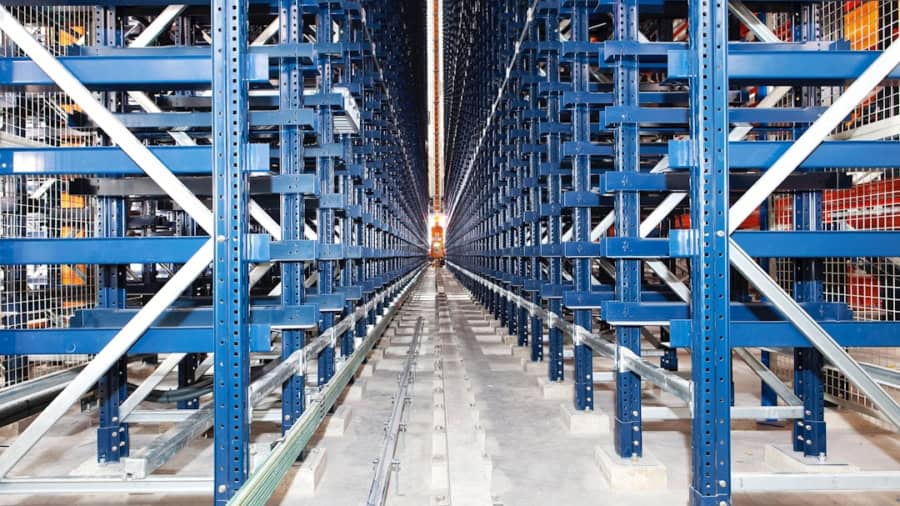The evolution of warehousing has undergone a significant transformation over the past few decades, driven by advancements in technology and the increasing demand for efficiency in supply chain management.
These systems are designed to operate with minimal human intervention, utilizing automated guided vehicles (AGVs), drones, and sophisticated inventory management software to streamline processes.
The rise of e-commerce has further accelerated this trend, as companies seek to meet the growing consumer expectations for rapid delivery and real-time inventory tracking. As businesses strive to enhance their operational capabilities, fully autonomous warehousing systems offer a compelling solution to the challenges posed by traditional warehousing methods. Companies like Amazon and Alibaba have pioneered the implementation of these systems, showcasing their potential to optimize storage space, reduce labor costs, and improve order fulfillment speed.
The integration of Internet of Things (IoT) technology allows for real-time data collection and analysis, enabling warehouses to adapt quickly to changing demands. This shift towards automation is not merely a trend; it represents a fundamental change in how goods are stored, managed, and distributed across the globe.
Key Takeaways
- Fully autonomous warehousing systems are on the rise, utilizing advanced technologies such as robotics, automation, and artificial intelligence.
- Advantages of fully autonomous warehousing include increased efficiency, reduced operational costs, and improved accuracy, while challenges include high initial investment and potential job displacement.
- Artificial intelligence plays a crucial role in fully autonomous warehousing, enabling predictive maintenance, real-time decision making, and optimization of warehouse operations.
- The impact of fully autonomous warehousing on the labor force is a topic of concern, as it may lead to job displacement and the need for upskilling and retraining of workers.
- Integration of robotics and automation in fully autonomous warehousing systems is essential for streamlining processes, increasing productivity, and reducing human intervention.
Advantages and Challenges of Fully Autonomous Warehousing
The advantages of fully autonomous warehousing systems are manifold, with efficiency being at the forefront. Automated systems can operate around the clock without the need for breaks or downtime, significantly increasing throughput and reducing lead times. For instance, a fully automated warehouse can process thousands of orders daily, far surpassing the capabilities of a traditional warehouse staffed by human workers.
Additionally, these systems minimize human error, which can lead to costly mistakes in inventory management and order fulfillment. The precision of automated systems ensures that products are accurately picked and packed, enhancing customer satisfaction. However, the transition to fully autonomous warehousing is not without its challenges.
The initial investment required for automation technology can be substantial, often deterring smaller businesses from making the leap. Furthermore, integrating new technologies into existing infrastructure can pose logistical hurdles. Companies must also consider the ongoing maintenance and updates required to keep these systems running efficiently.
There is also a significant learning curve associated with training staff to work alongside automated systems, which can lead to temporary disruptions in operations. As organizations navigate these challenges, they must weigh the long-term benefits against the short-term obstacles.
The Role of Artificial Intelligence in Fully Autonomous Warehousing

Artificial intelligence (AI) plays a pivotal role in the functionality of fully autonomous warehousing systems. By leveraging machine learning algorithms and data analytics, AI enhances decision-making processes within warehouses. For example, AI can predict inventory needs based on historical data and current trends, allowing warehouses to optimize stock levels and reduce excess inventory.
This predictive capability not only improves efficiency but also minimizes waste, contributing to more sustainable operations. Moreover, AI-driven robotics are capable of learning from their environment and adapting to new tasks without extensive reprogramming. This flexibility is crucial in dynamic warehouse settings where product lines may change frequently or where seasonal fluctuations in demand occur.
AI can also facilitate real-time monitoring of warehouse operations, identifying bottlenecks or inefficiencies that may arise during the order fulfillment process. By continuously analyzing performance metrics, AI systems can suggest improvements or adjustments that enhance overall productivity.
The Impact of Fully Autonomous Warehousing on the Labor Force
The rise of fully autonomous warehousing systems has sparked considerable debate regarding their impact on the labor force. On one hand, automation has the potential to displace a significant number of jobs traditionally held by warehouse workers. Tasks such as picking, packing, and inventory management are increasingly being performed by robots and automated systems, leading to concerns about job security for those employed in these roles.
For instance, a report from McKinsey & Company estimates that up to 800 million jobs worldwide could be displaced by automation by 2030. Conversely, the shift towards automation also creates new opportunities within the labor market. As warehouses become more technologically advanced, there is an increasing demand for skilled workers who can manage and maintain these automated systems.
Roles in robotics programming, AI system management, and data analysis are becoming more prevalent as companies seek individuals with specialized knowledge to oversee their operations. Additionally, automation can lead to safer working conditions by reducing the need for human workers to perform dangerous tasks in hazardous environments.
Integration of Robotics and Automation in Fully Autonomous Warehousing
The integration of robotics and automation is at the heart of fully autonomous warehousing systems. Automated guided vehicles (AGVs) are commonly used to transport goods throughout the warehouse, navigating complex layouts with precision and efficiency. These vehicles are equipped with sensors and cameras that allow them to detect obstacles and adjust their paths accordingly.
For example, companies like Kiva Systems (now part of Amazon Robotics) have developed robots that can autonomously navigate through warehouses to retrieve items for order fulfillment. In addition to AGVs, robotic arms are increasingly utilized for tasks such as sorting and packing products. These robotic systems can work at speeds far exceeding human capabilities while maintaining high levels of accuracy.
The use of collaborative robots (cobots) is also on the rise; these robots are designed to work alongside human workers, assisting them with repetitive or physically demanding tasks while allowing humans to focus on more complex activities that require critical thinking and problem-solving skills.
Sustainability and Efficiency in Fully Autonomous Warehousing Systems

Sustainability is becoming an essential consideration in modern warehousing practices, and fully autonomous systems offer several avenues for enhancing environmental responsibility. Automated systems can optimize energy consumption by utilizing smart technology that adjusts lighting and temperature based on real-time occupancy data. For instance, energy-efficient LED lighting can be integrated into automated warehouses to reduce electricity usage during non-peak hours.
Moreover, autonomous warehousing systems contribute to waste reduction through improved inventory management practices. By accurately predicting demand and optimizing stock levels, companies can minimize overproduction and reduce excess inventory that may ultimately go unsold. This not only conserves resources but also lowers costs associated with storage and disposal of unsold goods.
Additionally, many automated systems are designed with recyclable materials in mind, further promoting sustainability within the supply chain.
Security and Safety Considerations in Fully Autonomous Warehousing
As warehouses become increasingly automated, security and safety considerations must be prioritized to protect both assets and personnel. Fully autonomous warehousing systems rely heavily on interconnected devices and networks, making them vulnerable to cyber threats. Ensuring robust cybersecurity measures is essential to safeguard sensitive data related to inventory management and customer information.
Companies must invest in advanced security protocols such as encryption, firewalls, and regular system audits to mitigate risks associated with cyberattacks. Safety is another critical aspect of fully autonomous warehousing operations. While automation can reduce workplace accidents by minimizing human involvement in hazardous tasks, it also introduces new safety challenges.
For example, the presence of autonomous vehicles navigating through crowded warehouse environments necessitates clear safety protocols to prevent collisions with human workers or other equipment. Implementing comprehensive training programs for employees on how to interact safely with automated systems is vital for maintaining a secure working environment.
The Future of Fully Autonomous Warehousing: Opportunities and Innovations
Looking ahead, the future of fully autonomous warehousing is poised for continued growth and innovation. As technology advances, we can expect even greater levels of integration between robotics, AI, and IoT devices within warehouse environments. Innovations such as advanced machine learning algorithms will enable warehouses to become more adaptive and responsive to changing market conditions.
For instance, predictive analytics could evolve to provide real-time insights into consumer behavior trends, allowing warehouses to adjust their operations proactively. Furthermore, the development of more sophisticated robotic systems will enhance the capabilities of fully autonomous warehouses. Innovations such as drones for inventory management or last-mile delivery could revolutionize how goods are stored and distributed.
As companies increasingly prioritize sustainability, we may also see a rise in eco-friendly automation solutions that focus on reducing carbon footprints while maintaining operational efficiency. In conclusion, fully autonomous warehousing systems represent a significant leap forward in supply chain management. While they offer numerous advantages such as increased efficiency and reduced labor costs, they also present challenges that must be addressed thoughtfully.
As technology continues to evolve, the integration of AI and robotics will play a crucial role in shaping the future landscape of warehousing operations.
In a recent article on the best software to create training videos, the importance of utilizing technology to streamline processes and improve efficiency is highlighted. This is particularly relevant to the discussion on the future of fully autonomous warehousing systems, as the implementation of advanced software tools can greatly enhance the training and operation of such systems. By leveraging cutting-edge technology like NeuronWriter SEO NLP Optimization, companies can optimize their content and improve their overall performance in the rapidly evolving landscape of autonomous warehousing. Additionally, the article on

